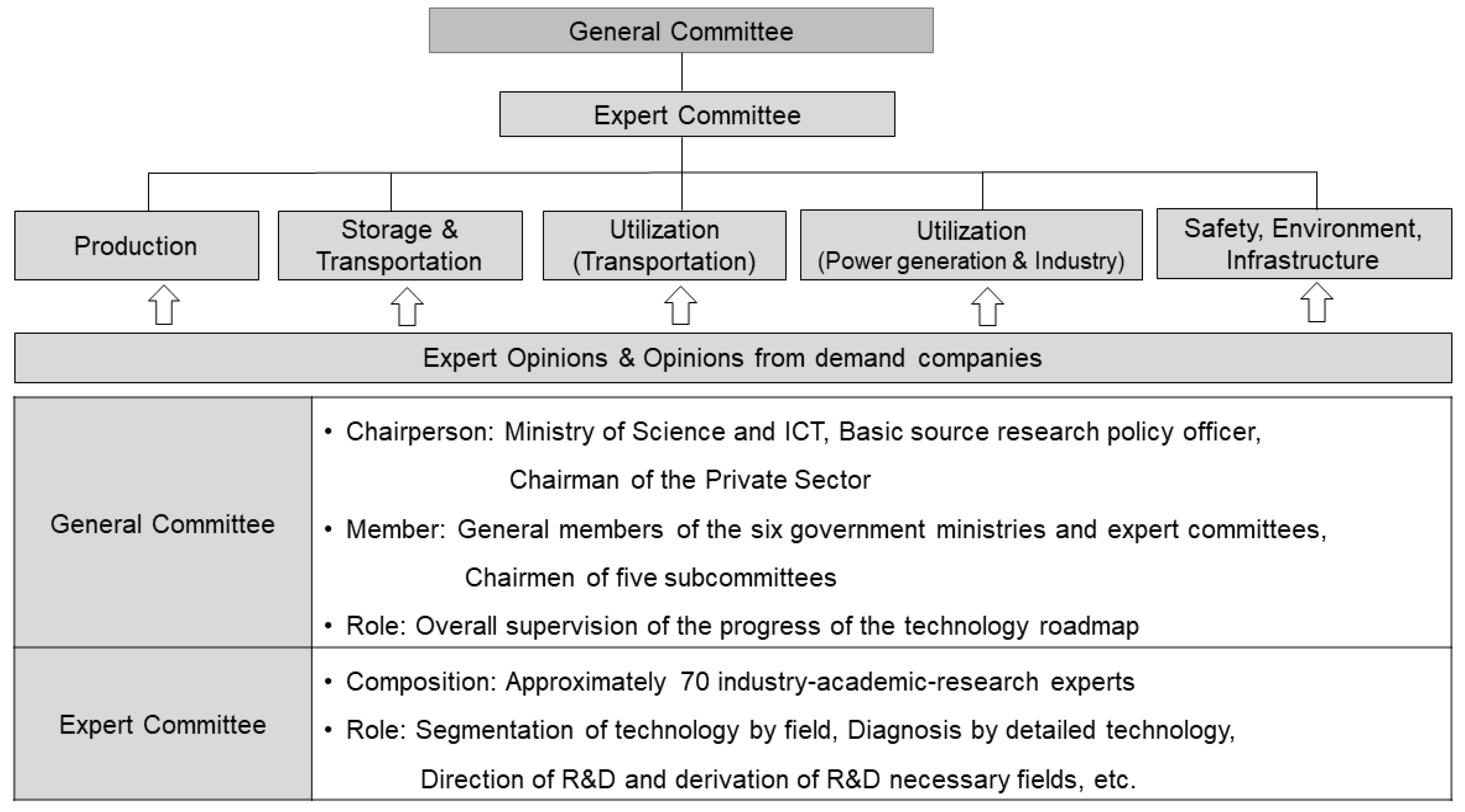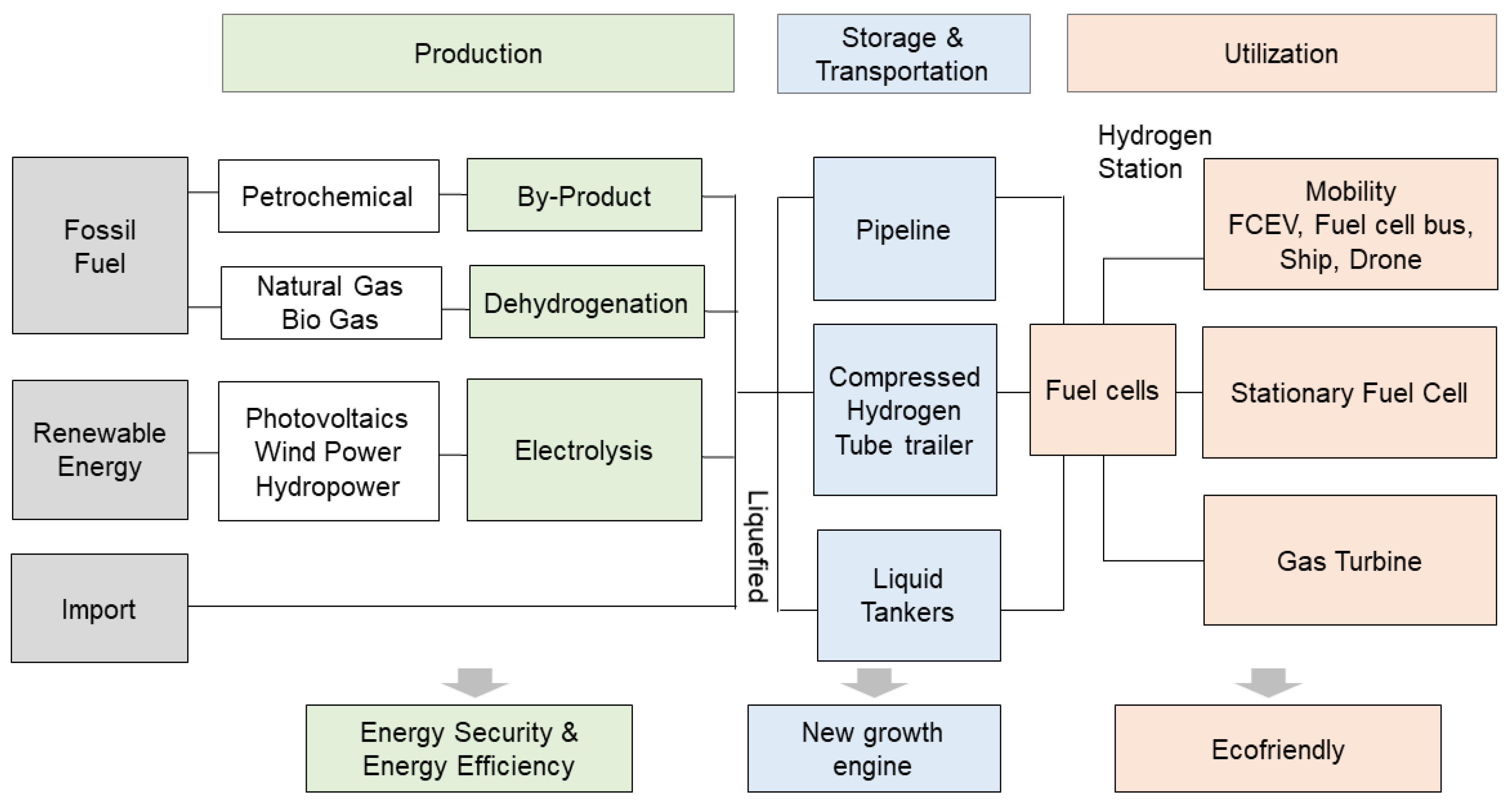South Korea developed its hydrogen strategies to achieve carbon neutrality and dominate the hydrogen economy amidst, and with the impetus, of the coronavirus disease 2019 (COVID-19) pandemic. The government strives toward the goal via continuous investment in green hydrogen technologies, as well as strategic collaborations.
1. Introduction
The “hydrogen economy”, which is defined as a society where hydrogen (named by Antoine-Laurent de Lavoisier in 1783 [
1]) is employed as the energy carrier in its energy system [
2], emerged as a term in the early 1970s, following the oil crisis (1973–1974), as a strategy for eradicating the energy dependence of the West on the Middle East [
3,
4]. Since passing three international treaties, namely, the United Nations Framework Convention on Climate Change (UNFCCC, 1992), the Kyoto Protocol (1997), and the Paris Agreement (2015), developing and developed nations, including the US, Japan, as well as the EU have been competing to dominate the hydrogen economy, with the impetus of the coronavirus disease 2019 (COVID-19) pandemic [
5,
6,
7]. South Korea (hereafter called Korea) ratified the agreement to join the global hydrogen competition on 3 November 2016 [
8].
Governments across the globe have developed their hydrogen strategies as the centerpieces of their grand master plans to achieve carbon neutrality by reducing the emission of greenhouse gases (GHGs) [
2,
9]. In July 2020, the European Commission also adopted the “EU Hydrogen Strategy” as part of the European Green Deal, with strategic objectives, such as the installation of ≥40 GW renewable hydrogen electrolyzers, as well as the production of up to 10 × 10
6 metric tons of renewable hydrogen each year until 2030 [
10,
11]. The Hydrogen Program Plan of the US Department of Energy, which was based on the National Hydrogen Energy Technology Roadmap (2002), was unveiled in November 2020 with key application-specific targets, such as achieving a hydrogen production of USD 2/kg and delivering and dispensing for the transportation applications by USD 2/kg. Moreover, the “Road Map to a US Hydrogen Economy”, which was released in March 2020 by the Fuel Cell and Hydrogen Energy Association (FCHEA), a Washington-based trade association, to achieve the hydrogen economy mission of the US, targets a hydrogen demand of >1.7 × 10
6 metric tons across different applications (with 1.2 million fuel cell vehicles (FCEVs) sold, 300,000 material-handling FCEVs in the field, and 4300 fueling stations across the nation) by the end of 2030 [
12]. In 2017, the Government of Japan designed its “Basic Hydrogen Strategy”, which aims to expand the fuel supply to 3 × 10
5 metric tons/annum and supply 8 × 10
5 FCEVs, 1200 hydrogen buses, and 900 hydrogen fuel stations by 2030. Further, with regard to the annual volume targets, even the ambitious 10 million metric tons/annum can be employed to envisage the 2050 target [
13]. Further, the Korean government announced its “Hydrogen Economy Roadmap” in January 2019 to achieve carbon neutrality, thereby improving hydrogen-related technologies and industrial structures [
9,
14,
15].
Although numerous studies have been devoted to emphasizing the resolve of the Korean government to reduce GHG emissions via several national hydrogen strategies that are based on effective collaborations with different stakeholders, such as private companies, academia, research institutes, and agencies, as well as ongoing public investments in green hydrogen technologies owing to concerns that are interlinked to climate change, air pollution, energy security, and global competitiveness in key industries [
7,
9], further studies are still required to develop a systematic framework for collaboration and investment for the hydrogen economy of Korea. To bridge this gap, a systematic collaboration and investment framework is proposed here. The framework supports the organization of a committee comprising stakeholders, and the implementation of the national hydrogen strategy, by presenting valuable and detailed information on public investments, as well as relevant implementation actors who can become the collaborative partners and/or members of the committee on a particular technology sector. Moreover, the proposed framework was applied to the value chain of the hydrogen economy to elucidate the implications of the strategy.
2. National Strategies of the Korean Hydrogen Economy
With the increasing global demand for renewable energy sources to deal with climate change, Korea is aiming at becoming a global leader in pioneering a hydrogen-based economy [
7,
9,
14]. The Korean government has emphasized its commitment to achieving net-zero carbon emissions by 2050 by announcing the “Hydrogen Economy Roadmap” (January 2019), establishing the “Hydrogen Economy Promotion and Safety Management Act” (Hydrogen Act) (February 2020 and enforced 5 February 2021), and establishing the “Green New Deal” (July 2020) [
7,
16]. These efforts have accelerated the production and utilization of hydrogen vehicles, the establishment of an ecosystem for producing and distributing hydrogen and other related technologies, and the production of fuel cells (FCs) [
9]. Recently, the plans for private investment in the hydrogen economy, along with government support, were approved at the third meeting of the Korean Hydrogen Economy Council.
Although Korea has invested in photovoltaics and wind energy, its onshore wind and solar potentials are very limited [
9]. Moreover, the Korean hydrogen industry is well-established and exhibits decades of experience in industrial energy employing hydrogen as a feedstock [
9]. Hydrogen can be produced via several processes, such as steam–methane reforming (SMR), coal gasification, renewable liquid reforming employing ethanol, and electrolysis. An electrolyzer is a device that employs electricity to split water into hydrogen and oxygen. When electricity that is produced from renewable energy sources is employed in this process, the produced hydrogen becomes a renewable energy carrier, complementary to the applied electricity [
9,
17]. The hydrogen energy technologies that are based on multi-energy systems that correspond to renewable energy, including solar, water, wind, and biomass energies, can improve the energy utilization rate and reduce the cost of hydrogen production and, therefore, represent the future of hydrogen energy [
18]. Thus, the Korean government has pursued a green hydrogen economy for economic growth, energy security, and an environment that aligns with domestic demands [
19].
The purposes of the Korean Green New Deal are sustainability and regional equality. Many scholars have emphasized that the major global Green New Deal initiatives, including those of the US (February 2019) and the EU (December 2019), are climate-oriented economic-stimulating policies that can improve investments, with beneficial economic output and jobs in the near future. These initiatives can also be the basis for the long-term innovation and economic development that correspond to environmental constraints. Thus, the initiatives reduce the gap between the regional inequalities within a country or those between countries [
20,
21,
22]. As aforementioned, the Korean Green New Deal that was announced on 14 July 2020, as well as the “Hydrogen Economy Roadmap” (January 2019), have announced the dual goals of considerably enhancing the hydrogen economy, and alleviating the resultant regional inequality within the country [
8,
23].
Following the Hydrogen Economy Roadmap (
Figure 1) [
15], the government instituted the Hydrogen Economy Council, which was led by the Prime Minister and comprised of eight ministries, including those of Trade, Industry, and Energy (MOTIE); Economy and Finance(MOEF); Interior and Safety (MOIS); Science and ICT (MSIT); Environment (MOE); Land, Infrastructure, and Transport (MOLIT); Oceans and Fisheries (MOF); and SMEs and Startups (MSS). Additionally, the government has instituted five committees of hydrogen experts to foster the research and development (R&D) collaboration between academic institutes, companies, and organizations since 2021. The five committees consist of production, storage/transportation, utilization for transportation, utilization for energy, and safety/infrastructure committees. The heads of the committees lead ~70 experts cut across academia, research institutes, and industries to divide a target domain into smaller segments for detailed analyses, after which they can propose the research fields for future investment.

Figure 1. Structure of the strategy committee for the Korean hydrogen economy [
15].
The Hydrogen Economy Roadmap of Korea is aimed at expanding the domestic production of hydrogen FCEVs in the transportation industry to 35,000 units by 2022 and 65,000 on South Korean roads. The prices of hydrogen vehicles are expected to compete with those of vehicles employing internal combustion engines, with 5 × 10
5-km durabilities, for 40 million won (USD 41,000) by 2025. For personal transportation, the roadmap includes the introduction of 80,000 hydrogen taxis and 40,000 hydrogen buses by 2040. It also includes the introduction of 30,000 hydrogen trucks over the same period for the transportation of freight. Similar to the adoption of electric vehicles, the lack of refueling stations still limits the extensive adoption of hydrogen-powered vehicles. Thus, the roadmap requires the expansion of the number of refueling stations from the present number of 34 to 310 and 1200 in 2022 and 2040, respectively. Regarding power generation and supply, the roadmap is aimed at increasing the production from 307.6 MW to 15 GW by 2040 employing FCs. On the basis of the roadmap, 8 GW of the generated power would be channeled to domestic consumption, while 7 GW would be dedicated to exports. Furthermore, the domestic price of a kilogram of hydrogen is expected to drop from 6500–7500 won (USD 5.42–6.25) to 3000 won (USD 2.5) by 2040 [
9].
Figure 2 demonstrates that the local government also plans to apply for a prefeasibility study toward establishing specialized hydrogen complexes in different regions, including Incheon (biohydrogen and byproduct hydrogen production), Jeollabuk-do (green hydrogen), Ulsan (hydrogen mobility), Gyeongsangbuk-do (hydrogen FCs), Gyeongsangnam-do (liquid hydrogen production), and Gangwon Province (liquefied hydrogen storage and transportation) [
24].

Figure 2. Local specialized regional hydrogen complexes [
24].
3. Value Chain of the Hydrogen Economy
The hydrogen economy depends mainly on the clean and efficient production of hydrogen, its storage on the supply side, and the commercial utilization of the energy that is generated across the hydrogen value chain on the demand side [
4,
7,
25].
Figure 3 demonstrates that the value chain of the hydrogen economy in Korea is thus: production–storage and transportation–utilization [
7,
15]. This concept of the hydrogen economy has been adopted by many scholars [
2,
7,
26,
27,
28]. Based on the definition of a hydrogen economy [
28], many hydrogen-production pathway technologies are being explored and developed for the production of hydrogen. Broadly, these include technologies for tapping into fossil resources via carbon capture, utilization, and storage (CCUS), extracting hydrogen from biomass and waste-stream resources, and splitting water [
28]. The energy content of hydrogen is nearly three times that of gasoline per unit of mass, although the volumetric energy density of hydrogen gas is low, posing a challenge to storing it in compact containers. To overcome this challenge, hydrogen is generally stored as a gas or cryogenic liquid via physical processes. It can also be stored via material-based processes by which it is incorporated with chemical compounds. To exhibit many applications, multiple technological pathways might be incorporated to transport hydrogen in different forms (as a gas via pipelines and high-pressure tube trailers, as a liquid via tanker trucks, and in chemical hydrogen carriers). Thus, there are four main media for transporting hydrogen on a large scale: gaseous tube trailers, liquid tankers, pipelines (for gaseous hydrogen), and chemical hydrogen carriers [
2]. Hydrogen is an energy carrier that is produced from energy and feedstocks, such as water, biomass, natural gas, coal, oil, and wastes. To be valuable, the energy content of hydrogen must be converted into different forms, such as electricity or heat. This conversion can be accomplished through an electrochemical process employing a FC. A FC utilizes the chemical energy of fuels, such as natural or synthetic gas and hydrogen, to produce electricity and thermal energy. FCs can be more efficient compared with internal combustion engines because the electrochemical reactions therein can directly generate electricity. FCs can employ many types of fuels and feedstocks and can serve as the power source for several applications across different sectors, such as the transportation, power-generation, and the industrial and manufacturing sectors [
28].

Figure 3. Value chain of the hydrogen economy [
7,
15,
28].



